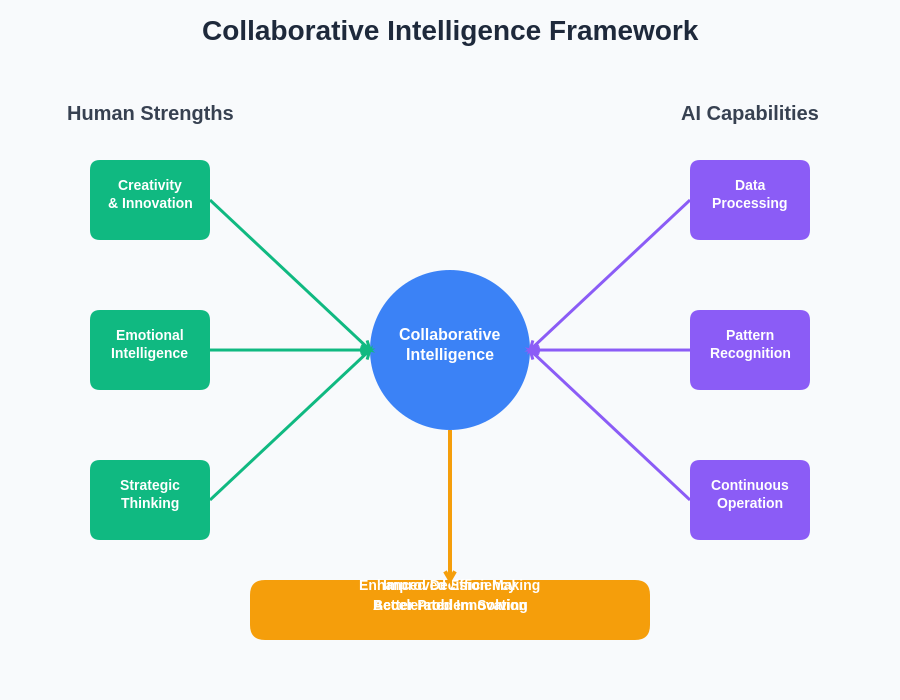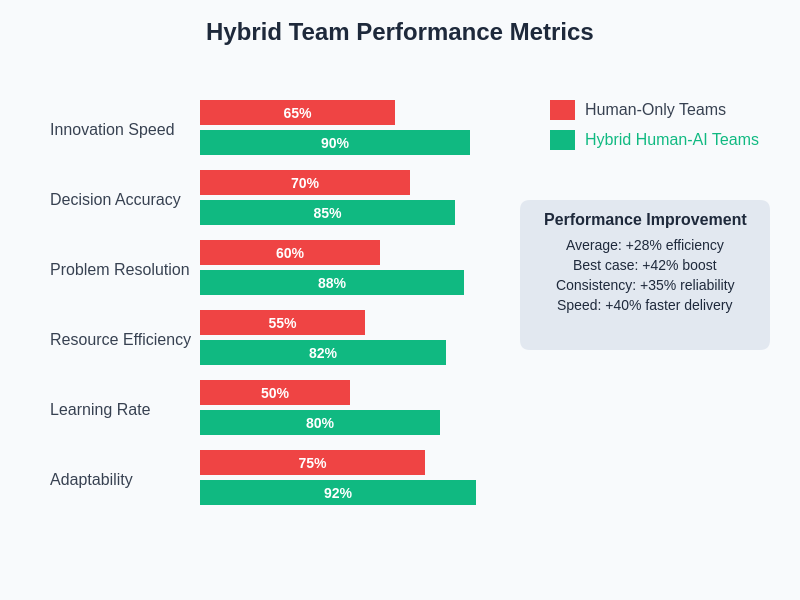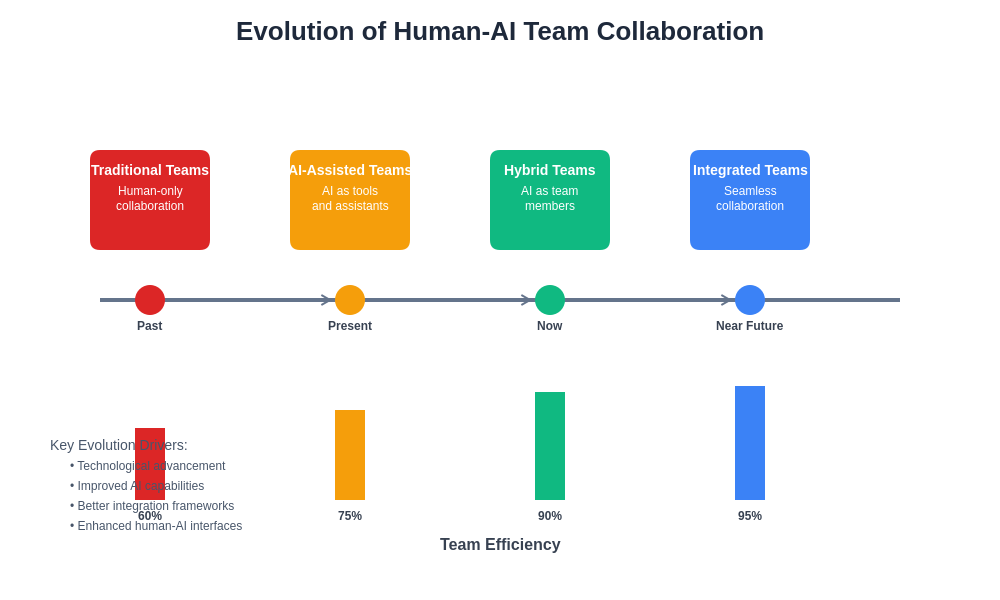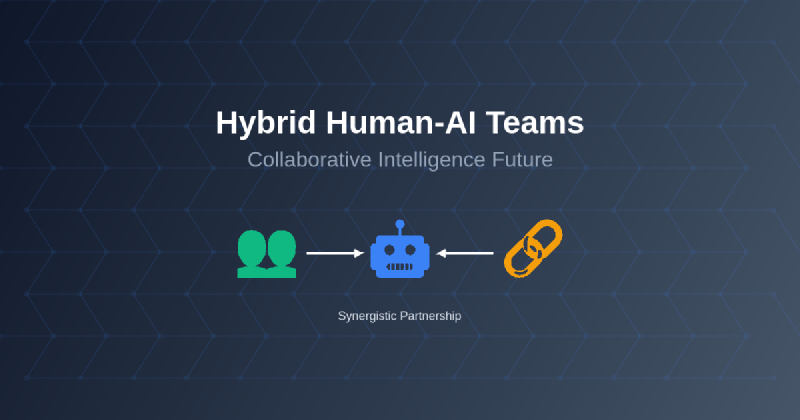The emergence of hybrid human-AI teams represents one of the most transformative developments in modern organizational design and collaborative intelligence. As artificial intelligence capabilities continue to evolve and mature, the traditional boundaries between human and machine contributions are dissolving, giving rise to new forms of collaborative partnerships that leverage the unique strengths of both human cognition and artificial intelligence. This revolutionary approach to teamwork is not merely about adding AI tools to existing workflows, but rather about fundamentally reimagining how teams operate, make decisions, and create value in an increasingly complex and dynamic business environment.
Explore the latest developments in AI collaboration to understand how cutting-edge technologies are reshaping team dynamics and organizational structures across industries. The fusion of human creativity, emotional intelligence, and strategic thinking with AI’s computational power, pattern recognition, and analytical capabilities creates synergistic effects that far exceed what either humans or AI systems can accomplish independently.
The Foundation of Collaborative Intelligence
Collaborative intelligence emerges when human and artificial intelligence systems work together in ways that amplify their respective strengths while compensating for individual limitations. This symbiotic relationship transcends the traditional view of AI as merely a tool or assistant, positioning artificial intelligence as a genuine collaborative partner capable of contributing unique perspectives, processing vast amounts of information, and identifying patterns that might escape human observation. The foundation of this collaboration rests on the understanding that human intelligence and artificial intelligence are fundamentally complementary rather than competitive forces.
Human team members bring irreplaceable qualities such as emotional intelligence, creative problem-solving, ethical reasoning, contextual understanding, and the ability to navigate ambiguous situations with intuition and experience-based judgment. These capabilities enable humans to excel in areas requiring empathy, moral reasoning, strategic vision, and adaptive thinking in unpredictable environments. Conversely, AI systems contribute computational power, consistent performance, rapid data processing, pattern recognition across large datasets, and the ability to work continuously without fatigue or bias from emotional states.
The most effective hybrid teams recognize and leverage these complementary strengths, creating workflows and decision-making processes that optimize the contribution of both human and artificial intelligence. This approach requires a fundamental shift in thinking about team composition, role definition, and collaborative processes, moving away from hierarchical structures toward more fluid, adaptive partnerships where responsibilities are distributed based on capability rather than traditional organizational roles.

The collaborative intelligence framework demonstrates how human strengths and AI capabilities converge to create enhanced outcomes that exceed the sum of their individual contributions. This synergistic relationship forms the foundation for truly effective hybrid teams that can tackle complex challenges with unprecedented efficiency and innovation.
Redefining Team Structures and Dynamics
Traditional team structures, with their clearly defined roles and hierarchical decision-making processes, are being reimagined in the context of hybrid human-AI collaboration. The integration of AI systems as team members rather than mere tools necessitates new frameworks for understanding team dynamics, communication patterns, and collaborative workflows. These evolved structures must accommodate the unique characteristics of AI systems while maintaining the essential human elements that drive innovation, creativity, and strategic thinking.
Experience advanced AI collaboration with Claude to see how sophisticated AI systems can integrate seamlessly into team environments and contribute meaningful insights to complex problem-solving scenarios. The redefinition of team structures involves creating new roles that bridge human and AI capabilities, establishing communication protocols that enable effective interaction between human and artificial intelligence, and developing governance frameworks that ensure ethical and responsible AI integration.
In these hybrid structures, traditional roles are evolving to include AI coordination responsibilities, where team members learn to effectively prompt, guide, and interpret AI outputs while maintaining oversight of AI-driven processes. New positions are emerging, such as AI trainers who specialize in optimizing AI performance for specific team objectives, human-AI interaction designers who create seamless collaborative interfaces, and collaborative intelligence architects who design and implement hybrid team workflows.
The dynamics within these teams are characterized by increased transparency in decision-making processes, as AI systems can provide clear reasoning for their recommendations and analyses. This transparency enables more informed human decision-making while creating opportunities for continuous learning and improvement in both human and AI capabilities. Team members develop new skills in AI collaboration, learning to effectively communicate with AI systems, interpret AI-generated insights, and integrate artificial intelligence contributions into broader strategic initiatives.
Augmented Decision-Making Processes
The decision-making processes within hybrid human-AI teams represent a significant evolution from traditional approaches, incorporating multiple layers of analysis, validation, and consensus-building that leverage both human judgment and AI-driven insights. These augmented processes enable teams to make more informed, timely, and effective decisions by combining human intuition and experience with AI’s ability to process vast amounts of data and identify complex patterns that might not be immediately apparent to human team members.
AI systems contribute to decision-making by providing comprehensive data analysis, scenario modeling, risk assessment, and predictive insights that inform human judgment. They can rapidly process historical data, identify trends, simulate potential outcomes, and present multiple scenarios for consideration, enabling human team members to make decisions based on more complete and accurate information. This analytical foundation supports human decision-makers while preserving the essential role of human judgment in areas requiring ethical considerations, strategic vision, and contextual understanding.
The augmented decision-making process typically involves AI systems performing initial data gathering and analysis, presenting findings and recommendations to human team members, facilitating collaborative discussion and evaluation of options, and supporting implementation through continuous monitoring and adjustment. Human team members maintain ultimate authority over strategic decisions while leveraging AI insights to enhance their understanding of complex situations and potential consequences of various choices.
This collaborative approach to decision-making has proven particularly effective in scenarios involving large datasets, complex variables, time-sensitive decisions, and situations requiring both analytical rigor and human insight. The result is a decision-making process that is simultaneously more data-driven and more human-centered, combining the best aspects of analytical and intuitive approaches to problem-solving.
Innovation Through Cognitive Diversity
The cognitive diversity inherent in hybrid human-AI teams creates unprecedented opportunities for innovation and creative problem-solving. Human and artificial intelligence systems approach problems from fundamentally different perspectives, with humans bringing creative, intuitive, and contextual thinking while AI systems contribute systematic analysis, pattern recognition, and the ability to explore vast solution spaces. This cognitive diversity generates novel insights and solutions that neither humans nor AI systems would likely discover independently.
Innovation emerges from the intersection of human creativity and AI analytical capabilities, where creative ideas are rapidly tested and refined through AI analysis, while AI-generated insights spark new creative directions for human exploration. This iterative process of creative generation and analytical validation accelerates innovation cycles and increases the likelihood of breakthrough discoveries. Teams can explore more possibilities, test ideas more rapidly, and iterate on solutions with greater speed and precision than traditional human-only teams.
The diversity of cognitive approaches within hybrid teams also reduces the risk of cognitive biases and blind spots that can limit innovation in traditional team settings. AI systems can identify patterns and possibilities that human team members might overlook due to experience-based assumptions or cognitive limitations, while humans can recognize opportunities and applications that AI systems might miss due to lack of contextual understanding or creative insight.
Leverage comprehensive AI research capabilities with Perplexity to enhance your team’s ability to gather and analyze information from diverse sources, supporting innovation through more complete understanding of market conditions, technological possibilities, and competitive landscapes. This enhanced research capability enables teams to base their innovative efforts on more comprehensive and current information.
Enhancing Human Capabilities Through AI Partnership
Rather than replacing human capabilities, AI partnership in hybrid teams serves to enhance and amplify human strengths while providing support in areas where humans may have limitations. This enhancement occurs across multiple dimensions of human performance, including analytical capabilities, memory and information processing, pattern recognition, and the ability to handle complex, multi-variable problems. The result is humans who are more capable, informed, and effective in their roles while maintaining their unique contributions of creativity, judgment, and interpersonal skills.
AI partnership enhances human analytical capabilities by providing rapid access to relevant information, performing complex calculations, and identifying patterns in large datasets that would be time-consuming or impossible for humans to process manually. This analytical support enables human team members to focus on higher-level strategic thinking, creative problem-solving, and relationship management while having access to comprehensive analytical insights when needed.
The enhancement extends to learning and skill development, where AI systems can provide personalized training, identify knowledge gaps, and suggest learning opportunities tailored to individual team members’ needs and objectives. This continuous learning support helps team members develop new capabilities and stay current with evolving industry requirements while maintaining their focus on core responsibilities.
Memory and information management are also significantly enhanced through AI partnership, with AI systems serving as external memory that can instantly recall relevant information, track project histories, and maintain comprehensive records of team activities and decisions. This support reduces cognitive load on human team members while ensuring that important information is readily available when needed for decision-making or problem-solving.
Overcoming Implementation Challenges
The implementation of hybrid human-AI teams presents several significant challenges that organizations must address to realize the full potential of collaborative intelligence. These challenges span technical, organizational, cultural, and ethical dimensions, requiring comprehensive strategies that address both immediate implementation needs and long-term sustainability of hybrid team approaches. Successful implementation requires careful planning, stakeholder engagement, and ongoing adaptation as teams learn to work effectively with AI systems.
Technical challenges include integrating AI systems into existing workflows, ensuring compatibility with current technology infrastructure, maintaining data security and privacy, and establishing reliable AI performance monitoring. Organizations must invest in appropriate technology platforms, develop technical expertise, and create robust governance frameworks that ensure AI systems operate effectively and safely within team environments.
Organizational challenges involve restructuring roles and responsibilities, developing new performance metrics, creating appropriate compensation and recognition systems, and establishing governance structures that support hybrid team operations. Traditional organizational models may not adequately address the unique characteristics of human-AI collaboration, requiring innovative approaches to team management, project coordination, and outcome evaluation.
Cultural challenges represent perhaps the most significant barrier to successful implementation, as team members must develop comfort with AI collaboration, trust in AI capabilities, and new working relationships that include artificial intelligence as genuine team members. This cultural transformation requires comprehensive change management, training programs, and ongoing support to help team members adapt to new collaborative models.
Ethical considerations include ensuring responsible AI use, maintaining human agency in decision-making, protecting individual privacy and autonomy, and establishing accountability frameworks that address the shared responsibility of human and AI team members. Organizations must develop clear ethical guidelines and governance structures that ensure hybrid teams operate in accordance with organizational values and societal expectations.
Industry Applications and Success Stories
Hybrid human-AI teams have demonstrated remarkable success across diverse industries, with applications ranging from healthcare and finance to manufacturing and creative industries. These real-world implementations provide valuable insights into the practical benefits and challenges of collaborative intelligence while demonstrating the transformative potential of human-AI partnership in various organizational contexts.
In healthcare, hybrid teams combining medical professionals with AI diagnostic systems have achieved significant improvements in diagnostic accuracy, treatment planning, and patient outcomes. AI systems contribute rapid analysis of medical imaging, identification of potential drug interactions, and analysis of treatment effectiveness across large patient populations, while human medical professionals provide clinical judgment, patient interaction, and ethical decision-making. This collaboration has resulted in faster diagnosis, more personalized treatment plans, and improved patient satisfaction.
Financial services organizations have leveraged hybrid teams for investment analysis, risk assessment, and fraud detection, combining AI’s ability to process vast amounts of market data with human expertise in strategic planning and client relationship management. These teams have achieved superior investment performance, reduced operational risks, and enhanced customer service while maintaining the personal touch that clients value in financial relationships.
Manufacturing organizations have implemented hybrid teams for quality control, predictive maintenance, and supply chain optimization, where AI systems monitor equipment performance and predict maintenance needs while human team members handle complex problem-solving and strategic planning. This collaboration has resulted in reduced downtime, improved product quality, and more efficient operations.
Creative industries, including advertising, entertainment, and design, have discovered innovative applications for hybrid teams where AI generates initial concepts and variations while human creatives provide artistic direction, emotional resonance, and cultural sensitivity. These partnerships have accelerated creative processes while maintaining the human insight necessary for emotionally compelling and culturally relevant creative work.

The quantitative evidence for hybrid team effectiveness is compelling across multiple performance dimensions. Organizations implementing human-AI collaborative approaches consistently demonstrate superior outcomes in innovation speed, decision accuracy, problem resolution, and overall efficiency compared to traditional team structures.
Future Evolution and Emerging Trends
The future evolution of hybrid human-AI teams promises even more sophisticated forms of collaboration as AI capabilities continue to advance and organizations develop greater expertise in managing human-AI partnerships. Emerging trends indicate movement toward more seamless integration, enhanced AI emotional intelligence, improved natural language interaction, and more sophisticated collaborative problem-solving capabilities that will further blur the boundaries between human and artificial intelligence contributions.
Advances in AI technology are enabling more natural and intuitive human-AI interaction, with AI systems developing better understanding of human communication patterns, emotional states, and contextual cues. This enhanced interaction capability will enable more fluid collaboration and reduce the learning curve for team members adapting to AI partnership. Future AI systems will likely demonstrate improved ability to understand nuanced human communication and respond appropriately to emotional and social cues.
The development of more specialized AI systems designed specifically for collaborative environments will create opportunities for more targeted and effective human-AI partnerships. These systems will be optimized for team collaboration rather than individual task completion, with enhanced capabilities for group communication, consensus building, and collaborative decision-making that support team dynamics rather than replacing them.
Organizational structures will continue evolving to better accommodate hybrid teams, with new management approaches, performance evaluation methods, and career development paths that recognize the unique characteristics of human-AI collaboration. Future organizations may develop entirely new organizational models optimized for hybrid team performance, with flattened hierarchies and more fluid role definitions that adapt to project needs and team composition.
The integration of multiple AI systems within single teams will create opportunities for even more sophisticated collaborative intelligence, where different AI systems contribute specialized capabilities while human team members provide coordination, strategic direction, and quality oversight. This multi-AI approach will enable teams to tackle increasingly complex challenges while maintaining human control and ethical oversight.
Ethical Considerations and Responsible Development
The development and implementation of hybrid human-AI teams must be guided by strong ethical principles and responsible development practices that ensure these collaborative relationships benefit all stakeholders while minimizing potential risks and negative consequences. Ethical considerations encompass issues of privacy, autonomy, accountability, fairness, and the long-term impact of human-AI collaboration on society and individual well-being.
Privacy protection becomes more complex in hybrid team environments where AI systems have access to sensitive information about team members, organizational strategies, and collaborative processes. Organizations must implement robust privacy safeguards that protect individual and organizational information while enabling effective AI collaboration. This includes establishing clear data governance policies, implementing appropriate security measures, and ensuring transparent communication about data collection and use.
Maintaining human autonomy and agency in decision-making processes requires careful attention to the balance between AI assistance and human control. While AI systems can provide valuable insights and recommendations, ultimate decision-making authority must remain with human team members, particularly for decisions involving ethical considerations, strategic direction, or significant consequences for individuals or organizations.
Accountability frameworks must address the shared responsibility of human and AI team members while ensuring clear lines of responsibility for team outcomes and decisions. This includes establishing protocols for AI oversight, human review of AI recommendations, and clear documentation of decision-making processes that enable appropriate accountability and learning from both successes and failures.
Fairness and equity considerations include ensuring that AI systems do not perpetuate or amplify existing biases, that all team members have equal opportunities to contribute and benefit from hybrid collaboration, and that the benefits of collaborative intelligence are distributed fairly across different groups and communities. Organizations must actively monitor for bias in AI systems and implement corrective measures when necessary.
Preparing for the Collaborative Intelligence Era
Organizations and individuals must proactively prepare for the widespread adoption of hybrid human-AI teams by developing new capabilities, restructuring processes, and cultivating cultural attitudes that support effective human-AI collaboration. This preparation involves technical infrastructure development, skill building, organizational design, and cultural transformation that positions teams for success in the collaborative intelligence era.
Technical preparation includes investing in appropriate AI technologies, developing robust data infrastructure, implementing security and governance frameworks, and establishing monitoring and evaluation systems that ensure effective AI performance within team environments. Organizations must also develop technical expertise through hiring, training, or partnerships that enable successful AI implementation and ongoing management.
Skill development for team members must encompass both technical capabilities for AI interaction and soft skills for effective collaboration in hybrid environments. This includes training in AI prompting and interaction techniques, data interpretation and analysis, collaborative problem-solving methods, and communication skills that enable effective human-AI partnership. Team members must also develop comfort with ambiguity and change as AI capabilities continue to evolve.
Organizational design changes may include restructuring reporting relationships, redefining role descriptions, establishing new performance metrics, and creating governance structures that support hybrid team operations. Organizations must also develop new approaches to project management, quality assurance, and outcome evaluation that account for the unique characteristics of human-AI collaboration.
Cultural transformation involves building acceptance of AI as collaborative partners, developing trust in AI capabilities while maintaining appropriate oversight, and fostering environments that support innovation and experimentation with new collaborative models. This cultural change requires leadership commitment, clear communication about AI integration benefits and limitations, and ongoing support for team members adapting to new working relationships.
The preparation for collaborative intelligence must also include attention to workforce development and transition planning that ensures current employees can adapt to hybrid team environments while new talent acquisition strategies identify candidates with appropriate skills and attitudes for human-AI collaboration. Organizations must balance the need for innovation with responsibility to their workforce, ensuring that the benefits of collaborative intelligence are shared broadly rather than concentrated among a few.

The evolution from traditional human-only teams to seamlessly integrated hybrid teams represents a fundamental transformation in organizational capability and collaborative potential. This progression demonstrates increasing efficiency and effectiveness as teams learn to leverage the complementary strengths of human and artificial intelligence.
The collaborative intelligence era represents a fundamental shift in how teams operate, make decisions, and create value, requiring comprehensive preparation and thoughtful implementation to realize its full potential while addressing associated challenges and risks. Organizations that successfully navigate this transition will be positioned to achieve unprecedented levels of innovation, efficiency, and effectiveness through the power of human-AI partnership.
Disclaimer
This article is for informational purposes only and does not constitute professional advice regarding AI implementation or organizational strategy. The views expressed are based on current understanding of human-AI collaboration technologies and their applications in team environments. Readers should conduct their own research and consider their specific organizational requirements when implementing hybrid human-AI teams. The effectiveness of collaborative intelligence approaches may vary depending on industry context, organizational culture, and individual team dynamics.
